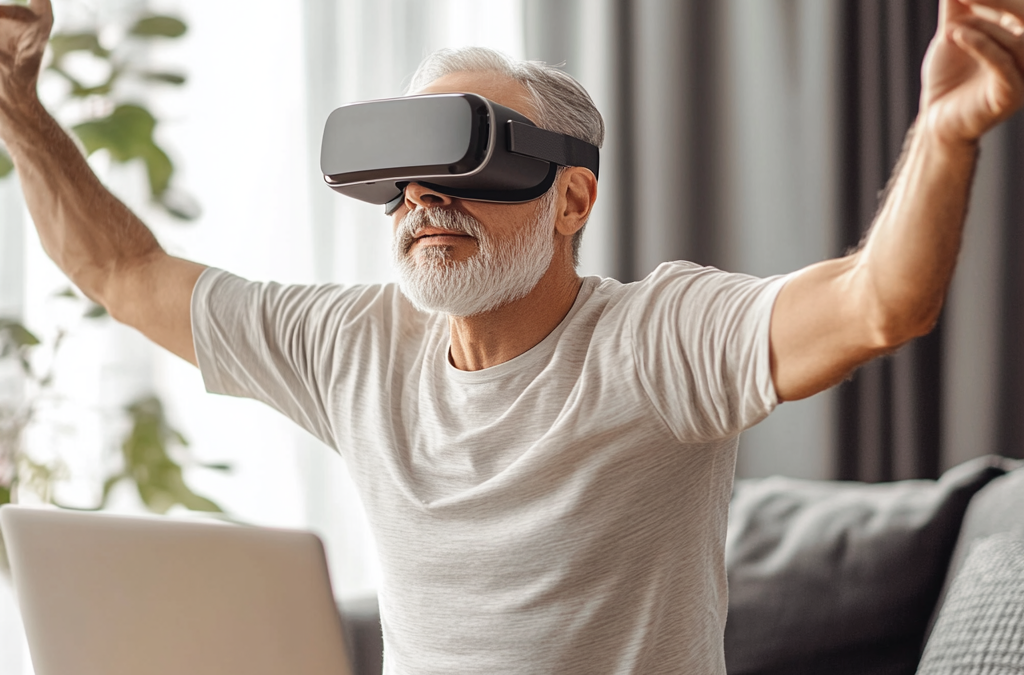Introduction
VR therapy leverages immersive technology to create interactive virtual environments that engage multiple senses. This multisensory engagement can modulate pain perception through several mechanisms:
- Distraction: Engaging in immersive VR experiences diverts attention from pain, reducing the subjective experience of discomfort. Research has shown that VR can effectively distract patients during painful procedures, such as wound care for burn victims, leading to reduced pain perception.
HEAL Initiative
- Neuroplasticity: Repeated VR sessions can promote neural adaptations, potentially altering pain pathways and reducing chronic pain over time. Preliminary studies have demonstrated that VR maintains its efficacy over repeated sessions, speeds up pain rehabilitation, increases the range of motion, and extends the duration of treatment effects.
PubMed Central
- Emotional Modulation: VR environments can induce positive emotions and relaxation, which are known to influence pain perception and reduce anxiety associated with chronic pain conditions.
Clinical Evidence Supporting VR Therapy
Numerous studies have investigated the efficacy of VR therapy in pain management:
- Acute Pain: A systematic review examining VR’s effectiveness for acute pain management found that immersive VR technology offers effective pain control across various medical procedures.
PubMed Central
- Chronic Pain: Research indicates that VR can be a valuable tool for managing chronic pain conditions. For example, a study on chronic low back pain demonstrated that an 8-week self-administered VR program led to significant reductions in pain intensity and pain-related interference with activity, mood, and stress.
jmir.org
- Cancer-Related Pain: In hospitalized cancer patients experiencing moderate to severe pain, a 10-minute immersive VR intervention resulted in improved self-reported pain scores compared to a two-dimensional guided imagery experience.
PubMed
VR Exercises for Pre-Session Preparation
To maximize the benefits of VR therapy, patients can engage in specific exercises before their sessions:
- Mindfulness Meditation: Practicing mindfulness can enhance the immersive experience of VR by promoting present-moment awareness and reducing anxiety. This mental state can make VR sessions more effective in diverting attention from pain.
- Controlled Breathing: Deep breathing exercises can induce relaxation, making it easier for patients to engage with VR content and benefit from its pain-relieving properties.
- Progressive Muscle Relaxation: Systematically tensing and relaxing muscle groups can reduce physical tension, complementing the immersive relaxation provided by VR environments.
- Visualization Techniques: Imagining calming scenarios can prime the mind for VR experiences, enhancing the sense of presence and immersion during the actual therapy session.
Duration and Frequency of VR Therapy Sessions
The optimal duration and frequency of VR therapy sessions can vary based on individual needs and specific pain conditions:
- Session Duration: Studies have utilized VR sessions ranging from 2 to 40 minutes. Shorter sessions may be effective for acute pain relief, while longer sessions might be beneficial for chronic pain management.
games.jmir.org
- Frequency: Treatment frequency has varied across studies, with sessions administered 5 to 7 times a week. Consistent and regular VR therapy sessions are associated with sustained pain relief and functional improvements.
games.jmir.org
- Treatment Duration: The overall duration of VR therapy programs has ranged from a single session to 8 weeks. Longer treatment durations have been linked to more substantial and lasting pain reductions.
games.jmir.org
Timeframe for Observing Pain Reduction
The onset of pain relief from VR therapy can vary:
- Immediate Relief: Many patients report immediate pain reduction during and shortly after VR sessions, particularly in acute pain scenarios. For instance, burn patients have experienced significant pain relief during wound care when using VR.
HEAL Initiative
- Short-Term Relief: In cases of procedural pain, VR has been effective in providing short-term pain relief during medical procedures.
PubMed Central
- Long-Term Relief: For chronic pain conditions, sustained engagement with VR therapy over several weeks has led to significant and lasting pain reductions. An 8-week self-administered VR program resulted in clinically meaningful symptom reduction for average pain intensity and pain-related interference with activity, mood, and stress.
jmir.org
Conclusion
Virtual Reality therapy represents a promising and innovative approach to pain management, offering a non-invasive, non-pharmacological alternative or adjunct to traditional treatments. By immersing patients in interactive virtual environments, VR therapy can effectively reduce pain intensity, improve functional outcomes, and enhance the overall quality of life. As technology advances and more research emerges, VR therapy is poised to become an integral component of comprehensive pain management strategies.

